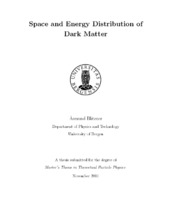Space and Energy Distribution of Dark Matter
| dc.contributor.author | Blitzner, Åsmund | eng |
| dc.date.accessioned | 2012-04-23T13:01:40Z | |
| dc.date.available | 2012-04-23T13:01:40Z | |
| dc.date.issued | 2011-11-17 | eng |
| dc.date.submitted | 2011-11-17 | eng |
| dc.identifier.uri | https://hdl.handle.net/1956/5764 | |
| dc.description.abstract | I start by an introduction to the notion of, and motivation for, Dark Matter, as well as a short motivation for supersymmetry, the theoretical framework usually examined when looking for places that dark matter may hide. After assuming a gravitino undergoing g → νγ decay, as a matter of convenience, there follows an exposition and use of the necessary tools to calculate the flux one might expect from galactic and extragalactic sources under such circumstances. The galactic model choice is given only a cursory glance, in anticipation of its ultimately minor importance to my main goal. That is, to determine if the decay of gravitinos over cosmological timescales is something that could influence our signal for reasonable values of the mean life. | en_US |
| dc.format.extent | 820715 bytes | eng |
| dc.format.mimetype | application/pdf | eng |
| dc.language.iso | eng | eng |
| dc.publisher | The University of Bergen | en_US |
| dc.title | Space and Energy Distribution of Dark Matter | en_US |
| dc.type | Master thesis | |
| dc.description.degree | Master i Fysikk | en_US |
| dc.description.localcode | MAMN-PHYS | |
| dc.description.localcode | PHYS399 | |
| dc.subject.nus | 752199 | eng |
| dc.subject.nsi | VDP::Mathematics and natural science: 400::Physics: 430:aparticle physics: 431 | en_US |
| dc.subject.nsi | VDP::Mathematics and natural science: 400::Physics: 430 | en_US |
| fs.subjectcode | PHYS399 |
